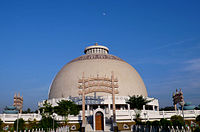Ambedkar believed that the Mahar people were an ancient Buddhist community of India who had been forced to live outside villages as outcasts because they refused to renounce their Buddhist practices. He considered this to be why they became untouchables and he wrote a book on this topic, entitled Who were the Shudras?.

Dikshabhumi, a stupa at the site where Ambedkar embraced Buddhism along with many of his followers
Ambedkar studied Buddhism all his life, and around 1950s, Ambedkar turned his attention fully to Buddhism and travelled to Sri Lanka (then Ceylon) to attend a convention of Buddhist scholars and monks.While dedicating a new Buddhist vihara near Pune, Ambedkar announced that he was writing a book on Buddhism, and that as soon as it was finished, he planned to make a formal conversion back to Buddhism.Ambedkar twice visited Burma in 1954; the second time in order to attend the third conference of the World Fellowship of Buddhists in Rangoon. In 1955, he founded the Bharatiya Bauddha Mahasabha, or the Buddhist Society of India. He completed his final work, The Buddha and His Dhamma, in 1956. It was published posthumously.
After meetings with the Sri Lankan Buddhist monk Hammalawa Saddhatissa,Ambedkar organised a formal public ceremony for himself and his supporters in Nagpur on 14 October 1956.
After publishing a series of books and articles arguing that Buddhism was the only way for the Untouchables to gain equality, Ambedkar publicly converted on October 14, 1956, at Deekshabhoomi, Nagpur. He took the three refuges and the Five Precepts from a Buddhist monk, Bhadant U Chandramani, in the traditional manner. Accepting the Three Refuges and Five Precepts from a Buddhist monk in the traditional manner, Ambedkar completed his own conversion, along with his wife Dr. Savita Ambedkar(née Sharada Kabir). He then proceeded to convert a large number (some 500,000) of his supporters who were gathered around him.He prescribed the 22 Vows for these converts, after the Three Jewels and Five Precepts. The conversion ceremony was attended by Medharthi, his main disciple Bhoj Dev Mudit, and Mahastvir Bodhanand’s Sri Lankan successor, Bhante Pragyanand. He then traveled to Kathmandu in Nepal to attend the Fourth World Buddhist Conference. Ambedkar would die less than two months later, just after finishing his definitive work on Buddhism. His work on The Buddha or Karl Marx and “Revolution and counter-revolution in ancient India” remained incomplete.
Many Dalits employ the term “Ambedkar(ite) Buddhism” to designate the Buddhist movement, which started with Ambedkar’s conversion. Many converted people called themselves as “Nava-Bauddha” i.e. New Buddhists.
Vows of Ambedkar

After receiving ordination, Ambedkar gave dhamma diksha to his followers. The ceremony included 22 vows given to all new converts after Three Jewels and Five Precepts. On 16 October 1956, Ambedkar performed another mass religious conversion ceremony at Chanda. He prescribed 22 vows to his followers:
- I shall have no faith in Brahma, Vishnu and Maheshwara nor shall I worship them.
- I shall have no faith in Rama and Krishna, who are believed to be incarnation of God, nor shall I worship them.
- I shall have no faith in Gauri, Ganapati and other gods and goddesses of Hindus nor shall I worship them.
- I do not believe in the incarnation of God.
- I do not and shall not believe that Lord Buddha was the incarnation of Vishnu. I believe this to be sheer madness and false propaganda.
- I shall not perform Shraddha nor shall I give pind-dan.
- I shall not act in a manner violating the principles and teachings of the Buddha.
- I shall not allow any ceremonies to be performed by Brahmins.
- I shall believe in the equality of man.
- I shall endeavor to establish equality.
- I shall follow the noble eightfold path of the Buddha.
- I shall follow the ten paramitas prescribed by the Buddha.
- I shall have compassion and loving-kindness for all living beings and protect them.
- I shall not steal.
- I shall not tell lies.
- I shall not commit carnal sins.
- I shall not take intoxicants like liquor, drugs, etc.
- (The previous four proscriptive vows [#14-17] are from the Five Precepts.)
- I shall endeavor to follow the noble eightfold path and practice compassion and loving-kindness in every day life.
- I renounce Hinduism, which disfavors humanity and impedes the advancement and development of humanity because it is based on inequality, and adopt Buddhism as my religion.
- I firmly believe the Dhamma of the Buddha is the only true religion.
- I believe that I am having a re-birth.
- I solemnly declare and affirm that I shall hereafter lead my life according to the principles and teachings of the Buddha and his Dhamma.
Nowadays many Ambedkarite Organisations are working for these 22 vows (i.e. 22 Pratigya). They believe that these vows only are responsible for the existence and rapid growth of Buddhism in India. The umbrella organization known as the 22 Pledges Practice & Propagation Movement (i.e. in Hindi- 22 Pratigya Aacharan aur Prachaar Abhiyan) is fully devoted for this purpose. This non-political movement is the brain-child of Arvind Sontakke, and comprises around 5,000,000 volunteers (Pracharaks), including many regional and local groups throughout India.
